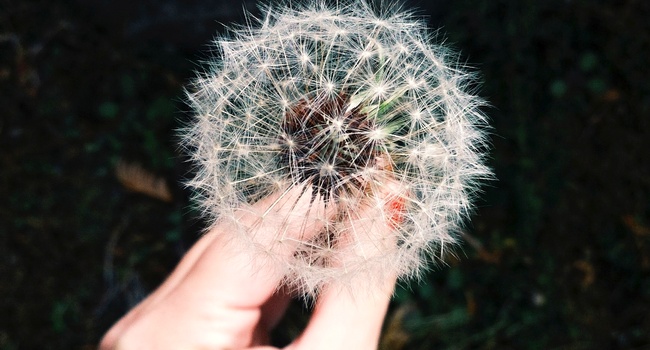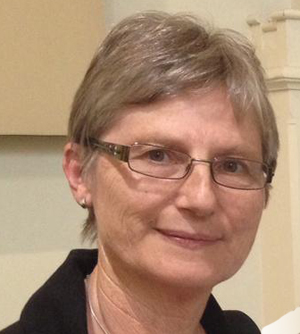September 24, 2018
Mercy Day
Life is a process of establishing relationships, of relating well, of seeking right relations. In Scripture, mercy is always a relational concept. Mercy grounds both the covenant relationship of God with God’s people and the relationships of God’s people with one another and with creation.

Image. Delicate by Coley Christine. Unsplash. Used with permission
The concept of mercy, which is a summary of the people’s understanding of God, is beyond being able to be expressed by one word. In scriptural language, mercy is like a prism with many fine cuts: different groups of words like hesed or rahamim refract distinctive aspects of mercy and at times are used interchangeably. However refracted, mercy in Scripture is always action-orientated.
Relational and action-orientated mercy, then, is best expressed as a verb, a doing word, as in the beatitude: 'Blessed are the merciful for they shall be mercied' (a more literal translation of Matt 5:7). This sense of being 'mercied' and 'mercying' is in our Mercy DNA for the works of mercy led Catherine’s action-orientated founding band to be known as the walking sisters. Right relation, too, is best expressed as a verb or a doing word rather than as a noun or a naming word. Maori, the first people of Aotearoa New Zealand have a wonderful expression in verbal form, whakawhanaungatanga 1 which in three interconnected sets of making right relationship offer insight into the making-right- relation core of biblical mercy. This verb comprises a noun and a causative prefix.
The noun, whanaungatanga (right relationship), as theologian Henare Tate explains, is “the complex totality” which 'holds the multi-faceted identity we inherit from our tupuna (our many ancestors) and matua (parents) … The further we go back in whakapapa [genealogy] … the richer is our identity.' Being connected in this way 'also connects us to their spiritual taonga (treasures) of te reo (language), tikanga (culture), matauranga (knowledge), and tapu (sacredness) and mana (spiritual power and authority).'2 This set of right relationship arising from genealogy in the generic sense of tangata (the human being, the people) begins in another set of relationship with Io-Matua-kore (the parentless one), God (Atua) the source of all whanaungatanga. The third set of right relationship with whenua (land), in all its physical and spiritual dimensions, brings a person into intimate relationship with God and the universe.
Papatuanuku, the traditional personified name for Earth, and whenua, the common name, encompass all its geographical and physical features. The sky and the heavens, the stars, the sun and the moon, the winds and the like are understood to have an influence on the whenua. Plants, trees, birds, animals, sea creatures and all living organisms 'find their place within a providential ordering of creation.' The one word whenua means both the land and the human placenta. In Maori consciousness, then, these three sets of right relationship – with people, God and land – are interrelated systematically and dynamically. If one enhances or diminishes one’s relationship with God, one’s relationship with the people and with the land is also enhanced or diminished.
In this understanding, right relationship is a verb. The causative prefix, whaka suggests 'making' and turns the noun, whanaungatanga (right relationship) into the verb, whakawhanaungatanga meaning 'making right relationship' in a series of interconnected relationships with God, creation and people. Consequentially, in the Maori world, a speaker begins a mihi (speech) by acknowledging God, creation and the people to situate themselves within their whakapapa (genealogy). A speaker greets the land on which one stands and identifies oneself by naming one’s tribal mountain and river. Family and tribal affiliation are made with people present. In the recitation of genealogies or stories about the physical and spiritual world, people celebrate and deepen their identity.
These interconnected relationships of 'making right relationship,' particular to the Maori worldview and sustained among them over a changing story, is found in indigenous people worldwide. This worldview, for example, in the face of colonial, economic and environmental injustice in Kenya inspired the Green Belt Movement founder and Nobel Peace Prize winner, Wangari Maathai to empower women to plant trees for fuel, shade and food. An international movement of indigenous peoples, First Peoples Worldwide states: “we are descended from the pre-colonial/pre-invasion inhabitants of our region. We maintain a close tie to our land in both our cultural and economic practices. We suffer from economic and political marginalization as a minority group. A group is considered Indigenous if it defines itself that way.”
Genealogies preface the stories of biblical characters (Gn 5-9; 11:10-32). If the story of Jesus did not begin by asserting his identity through his genealogy, Matthew’s original readers would have been surprised for their interest in ancestry flowed from their tribal origins as God’s people. Matthew’s first two words, biblos geneseos may be translated as 'the book of the genealogy.' These words are together in only two places in the Greek Bible where they suggest the beginning of the heavens and the earth (Gn 2:4) and signify the genealogy of the descendants of Adam (5:1). Thus, Matthew places Jesus in God’s renewal of creation and inserts him into a history and people. Some ancestors are less than savoury signalling that Jesus will choose sinners over the just. Unknown characters anticipate the reign of God where the insignificant and unknown become disciples. Socially, economically and culturally marginal Gentile women outsiders ensured the lineage which from Jesus will be born continued and foreshadow his mission.
In this Year of Consecrated Life, religious are invited to: 'Wake up the World.' Celebrating and deepening our identity is at the heart of this call. To articulate our identity with people, God and creation through genealogy is a means of making right relationships. Catherine McAuley insisted that her sisters be centred in God. The tender mercy of God and the love that exists among sisters and those with whom they minister and live permeated her life and instructions. Catherine insisted that local sisters knew their local area and its particularities best. Place is extended now to environment and creation which were arguably implicit when she prayed psalms such as Ps 136 where creation comes into being through God’s steadfast love (hesed) which endures forever. Hesed is often associated with hospitality especially in the sense of meaning right relationship between host and guest. This richly layered concept which holds layers of grace, justice, fidelity and compassion is expressed in various words by translators of the Hebrew Bible into Greek. Among these is the word for justice (dikaiosume) which often translates the Hebrew word for justice (sedeqah) in the sense of right relationship.
Relational, action-orientated mercy draws me into my genealogy to deepen my identity by whakawhanaungatanga /making right relationship with God, people and creation in a local and global context. I come before my God of mercy … I greet the land which lies before me… I greet the living universe… I acknowledge Kai Tahu (local tribe) … I am Kathleen. I am Pakeha 5 descended from Irish and English ancestors who came to Aotearoa in the 1860s-70s … I acknowledge those who have gone before me … My Nga Whaea Atawhai Sisters of Mercy genealogy began in this land in 1850… Prior to the arrival of my ancestors, the founding document of our nation Te Tiriti o Waitangi (Treaty of Waitangi) was signed in 1840 … I continue … I invite my reader to begin …
1. Pronounced facka-far-noe-ngar-ta-ngar (ng counts as one consonant and is pronounced like “gn” in the word “singer.”)
2. Henare Tate. 'Stepping into Maori Spirituality.' In Helen Bergin and Susan Smith. Eds. He Kupu Whakawairua Spirituality in Aotearoa New Zealand: Catholic Voices. Auckland: Accent Publications, 2002, 41-43.
3. Henare Tate, He Puna Iti i te Ao Marama: A Little Spring in the World of Light. Auckland: Libro International, 2012, 39, 58, 71-72.
4. First Peoples Worldwide http://firstpeoples.org
5. Describes a New Zealander of European descent.
Opening Hymn: Wake up the world with dawning joy
Reflection: 'I will be a hummingbird' - Wangari Maathai (02:00)
Opening hymn: 'Pax Amor Christi' composed and sung by Kathleen Deignan CND
Purchase on *iTunes * Google Play
I acknowledge Tui Cadigan rsm and Gabrielle Huia who read my work
First Peoples Worldwide
Lawson, Veronica. rsm. 'Mercy the enduring and liberating love of our womb-compassionate God', can be viewed online here (1:20:39). A web-ready version of the booklet can be downloaded here (11pps; PDF)
Rushton, Kathleen. rsm. 'Whakapapa of Jesus.' Tui Motu InterIslands. December 2014, 26-27. (PDF)
Rushton, Kathleen. RSM 'But she said…: A Female Genealogy' (Matt 15:21-28). Tui Motu InterIslands. August 2011, 26-27.
Tate, Pa Henare. He Puna Iti i te Ao Marama: A Little Spring in the World of Light. Auckland: Libro International, 2012, 38-40. (PDF)
Tate, Pa Henare. “Stepping into Maori Spirituality.” In Helen Bergin and Susan Smith. Eds. He Kupu Whakawairua Spirituality in Aotearoa New Zealand: Catholic Voices. Auckland: Accent Publications, 2002, 37-53. (PDF)
Mohi, Hinewehi - Lines in the Sand (52:07)
Wainwright, Elaine.rsm. Extravagant Mercy—A New Story in an Ecological Key
Taking Root: The Vision of Wangari
Maathai, Wangari. Replenishing the Earth: Spiritual Values for Healing Ourselves and the World (New York: Doubleday Image, 2010).(14pps; PDF). See also her publications list here
Dirt! The Movie - Trailer (02:07)
Dirt! The Movie - Complete film (1:20:24)
Messages to: Kathleen Rushton rsm

Kathleen's current research interests include the cosmology of John’s gospel, water imagery and the implications for science and religion today.